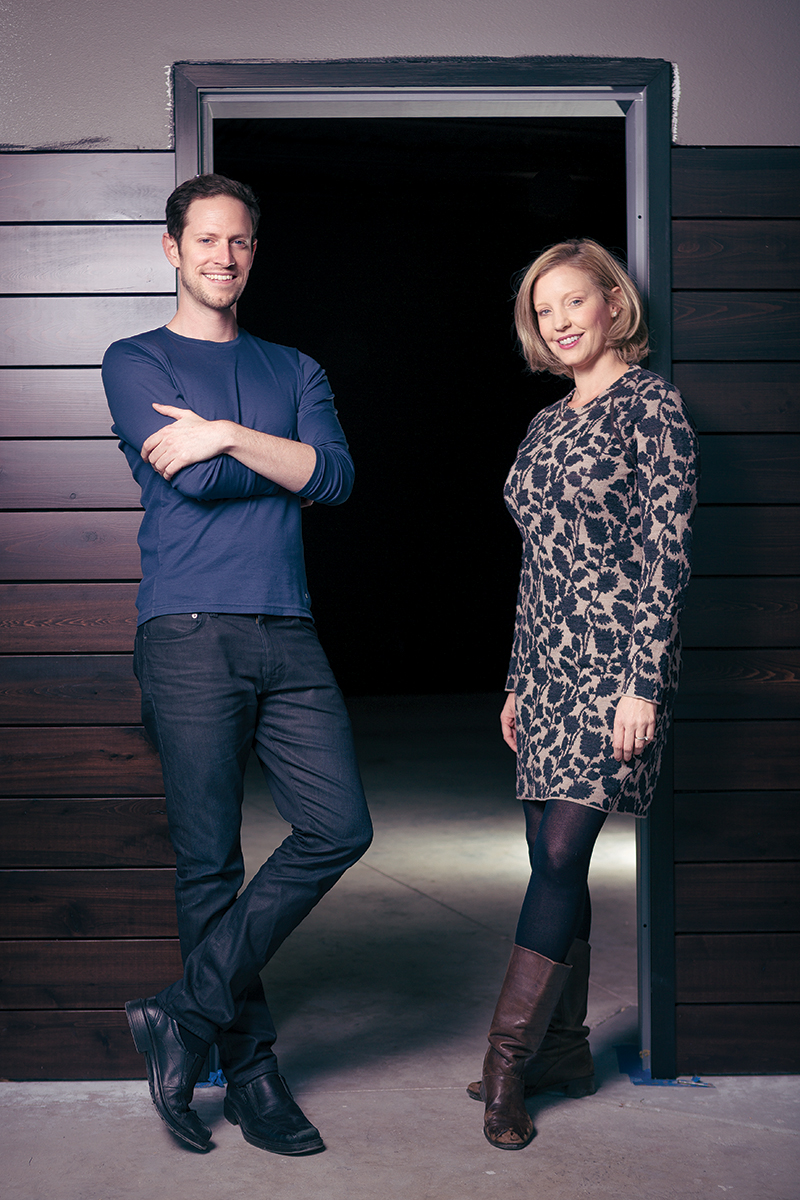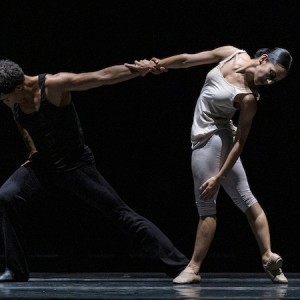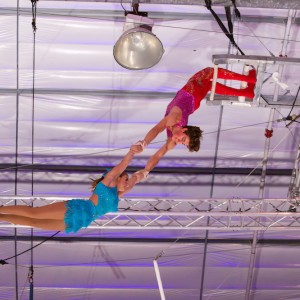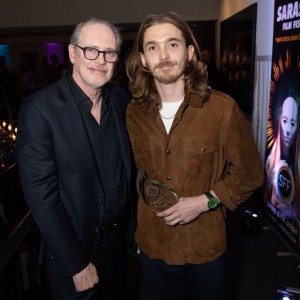“If theater doesn’t change between now and 40 years from now, I’m not sure people will go to theaters. We need to start looking to the future,” Brendan Ragan says. The Urbanite Theatre’s mission statement rings clear: This isn’t just theater, this is an intervention. Looking around the supposed cultural capital of Florida, Urbanite co-founders Ragan and Summer Dawn Wallace see missed opportunities and unengaged youth. Established theaters enjoy steady patronage from the older demographic, but don’t seem able to compete with more modern forms of entertainment for the attention of younger generations. To Ragan and Wallace, this represents a problem that Sarasota cannot ignore, but one that the Urbanite aims to fix.
No strangers to the Sarasota theater scene, Ragan and Wallace graduated from the FSU/Asolo Conservatory for Actor Training in 2013 and 2012 respectively. Though separated by only one year, the two students never acted together and had little social interaction. “In the Conservatory, they own your existence,” explains Ragan. Between classes, workshops and performances, free time remains a scarce commodity. “And then when you do have spare time, you’re like, ‘I don’t want to see any of you,’” jokes Wallace.
It wasn’t until after graduating, when Wallace returned to the area for a production of Cat On A Hot Tin Roof after performing in New York, that she began to seriously consider starting her own theatre troupe and taking more artistic control over her projects and opportunities. She called Ragan, knowing that he had been a founding ensemble member of the Single Carrot Theatre company in Baltimore and was in Tampa for a production of Venus In Furs. Ragan agreed to meet. Though they had little interaction at the Conservatory, they were well aware of each other’s work and chance meetings in the halls would stretch into hour-long conversations on art and theater. On top of that, they each enjoyed a reputation as being people that got things done. “Within our own class, we were both doers,” says Wallace. “If there was something to be organized?” She trails off, gesturing alternately between Ragan and herself.
“The first time we sat down, we did not enter that meeting saying, ‘I want to start a company. Come to the table with some ideas,” says Ragan. Wallace wanted to pick Ragan’s brain, not enter into a partnership, but as the conversation progressed “a smaller idea turned into a bigger idea,” says Wallace. “By the end of the meeting, we agreed so fervently across the board about the kind of work that we really like, the kind of theater already in Sarasota and what was missing,” says Ragan. Unintentionally, Wallace had found a business partner, and starting a troupe began to look like building a theater. Wallace and Ragan shared a vision for a small-scale venue that could serve as a haven for the experimental and cutting-edge, a place that could provide steady work for rising artists while bringing in a new theater-going crowd.The two began pursuing their options and when they found an anonymous backer with similar passions, they brooked little hesitation.
“I grabbed it, took it and ran with it,” says Wallace. Purchasing an office and a lot off Second Street, they began renovation and construction in September 2014. Gone are the Spanish tiles and salmon hues across the façade, replaced with metalwork and dark greys and cobalt blues. A glimmering marquis will shine where the old awning draped. Behind it all rises the newly constructed theater proper. A simple blackbox design, relatively unadorned on the exterior, the jet black interior can be transformed with minimal cost and set construction, relying on specific scene-setting props and the audience’s imagination to fill in the gaps. The space is malleable, allowing the shape of the stage to change by simply rearranging the audience’s chairs. “It gives us the most flexibility for the material that we want to do,” says Wallace. It also creates a more intimate space for both the audience and the performers, according to Wallace, with no formal stage separating the two, only the fourth wall. “That’s a very different theatrical experience. The audience is submerged in the play.” Changing the theater experience is fundamental to what Ragan and Wallace are trying to do in Sarasota. To reconnect with the audience, the theater has to take proactive steps, says Ragan, not simply wait for the audience to come to them.
“There’s not going to be a simple answer,” says Ragan, as to how theater can maintain its relevance in a changing world. He sees theaters making efforts to engage younger audiences through individual shows or truncated social media campaigns, but never much of a concerted effort. These attempts are doomed to fail, he says. “It never ends up working because they’re an established brand and trying to do something different. We’re going to do it from the beginning.” Designed from the ground up to reshape the Sarasota theater scene and engage the younger generation, Ragan and Wallace’s plan comprises a three-pronged effort focusing on quality content, accessibility and presence.
Content is key and the theater has to be able to tell stories and give experiences similar to those the younger crowd seeks out on the small screen. As TV has adapted its programming to the times, making room for different types of stories as well as embracing the darker and rougher sides of life that can make shows such as Breaking Bad and The Wire hits by seeming more “real” than their predecessors, there’s no reason that theater cannot tell those stories as well–modern stories with a gritty edge, unapologetic and unafraid. “We need to,” says Ragan. “We can’t live in this candy-coated bubble where everything is gentle and conservative.” Still, they want to keep it edgy without venturing into cheap shock value that could drive away Sarasota’s established theater audience. On the other side of the operation, the greatest shift the Urbanite hopes to achieve is in changing the way that going to the theater is viewed in Sarasota. Currently, they say, it appears as something reserved for the elite. “If you’re not a theatergoer, some of the theaters are intimidating,” says Wallace, referring to the perceived aura of stuffiness and formality she views as a deterrent to younger crowds. “You’re the youngest in the crowd and you feel underdressed. We want to wipe that feeling away.”
Nights at the Urbanite will be more T-shirt-and-jeans affairs, as opposed to top hats and tails, says Ragan, who still holds to theater’s populist beginnings. Seeing a stage performance should be as potentially invigorating, fun and communal as a trip to the cinema on a Friday night.
Part of this will also entail tearing down the mystique that separates the performers on stage from an audience relegated to passive acceptance. “Part of seeing live theater is exploring the human condition together,” says Ragan. Already in closer quarters than usual due to the blackbox format, Wallace and Ragan hope to foster a greater connection between those on stage and those in the crowd with post-performance parties and meet-ups, where the two groups can interact in an even more casual setting.
With an eye to youthful hipness and ubiquity, Ragan and Wallace have also made affordability a central focus of the Urbanite’s productions. To foster a theater community amongst the younger demographic, there needs to be theater productions consistently available at a price that they can consistently afford. Seeing one show a season does not a thriving community make. By keeping prices low and the setting casual, Wallace and Ragan hope not only to convince people to see more shows, but also to consider a night at the theater as a spontaneous possibility that does not require weeks of budgeting and scheduling. By allowing the audience to make the decision to attend more freely, they will make it more often.
“It’s not going to happen overnight,” says Ragan. “We have to constantly be working at it.” Ragan and Wallace have been quick to enlist the help of the community, whether it be the anonymous donor who helped them purchase the lot or the budding playwright looking for a venue. The Urbanite will not sink or swim on its own, but as a part of the greater artistic community, giving voice to an underground scene formerly shackled by a lack of support.
More than just a venue for the the Urbanite’s productions, Wallace and Ragan see their new theater as an opportunity for artists of all stripes and are already planning musical performances, gallery shows and even some modern dance in the space. “That’s the most important thing an artist needs –space,” says Ragan, who envisions the Urbanite becoming the nucleus around which a new arts scene, something more experimental and reaching, can grow. “It’s going to take all of us constantly doing good work to show that the underground arts scene here is a good one.” So far, Ragan and Wallace remain optimistic but perpetually surprised at the enthusiasm with which the community has greeted their proposition from the very start, overfunding their Kickstarter campaign and selling out their events in less than a week.
“It was for the masses to come share an experience with each other and move forward as better people,” says Ragan on theater’s ancient and illustrious history, from Greece to Shakespeare, in all its bawdy glory, when playwrights were celebrated and the masses flocked to the latest productions. “There’s no reason that theater should not be that anymore.” SRQ

PHOTOGRAPHY BY EVAN SIGMUND










